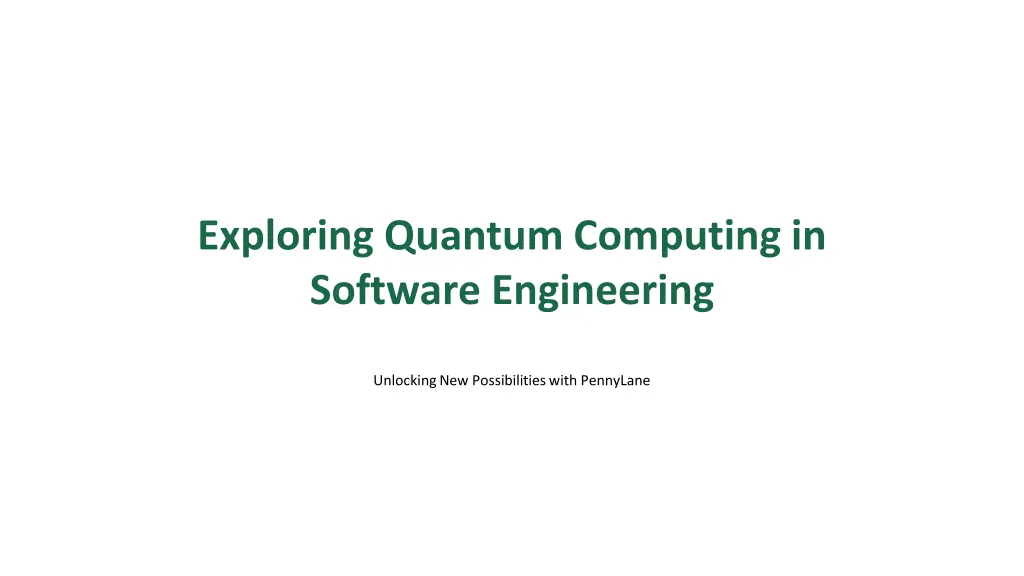
Unlocking Quantum Computing Potential in Software Engineering
"Explore the paradigm shift of quantum computing with PennyLane in software engineering, from understanding qubits to quantum machine learning applications, quantum chemistry revolution, and integrating quantum and classical systems for superior processing power and new possibilities."
Download Presentation

Please find below an Image/Link to download the presentation.
The content on the website is provided AS IS for your information and personal use only. It may not be sold, licensed, or shared on other websites without obtaining consent from the author. If you encounter any issues during the download, it is possible that the publisher has removed the file from their server.
You are allowed to download the files provided on this website for personal or commercial use, subject to the condition that they are used lawfully. All files are the property of their respective owners.
The content on the website is provided AS IS for your information and personal use only. It may not be sold, licensed, or shared on other websites without obtaining consent from the author.
E N D
Presentation Transcript
Exploring Quantum Computing in Software Engineering Unlocking New Possibilities with PennyLane
01 Understanding Quantum Computing Table of Contents 02 Introduction to PennyLane 03 Quantum Machine Learning Applications 04 Quantum Chemistry Revolution 05 Integrating Quantum and Classical Systems 06 Community and Collaboration 07 Challenges in Quantum Software Engineering 08 Future Trends in Quantum Computing 09 Practical Implications for Software Engineers 10 Thank You!
1 Understanding Quantum Computing Quantum computing represents a paradigm shift in computation, leveraging the principles of quantum mechanics. It uses quantum bits (qubits) that can exist in multiple states, unlike classical bits. This capability allows for vastly superior processing power for specific complex problems. Industries from finance to pharmaceuticals are exploring quantum solutions for optimization. The future of technology hinges on our ability to harness this potential.
2 Introduction to PennyLane PennyLane is an innovative open-source framework designed for quantum machine learning. It integrates seamlessly with popular machine learning frameworks, bridging the gap between quantum and classical computing. With PennyLane, developers can build and train quantum machine learning models easily. Its versatility makes it suitable for applications in quantum chemistry and physics. PennyLane democratizes access to quantum technology for developers and researchers.
3 Quantum Machine Learning Applications One of the most exciting applications of quantum computing is in machine learning. Quantum algorithms can process informationsignificantly faster than classical counterparts. PennyLane enables researchers to leverage quantum resources for enhanced learning models. This includes tasks like classification, regression, and clustering. The potential for breakthroughs in AI is immense.
4 Quantum Chemistry Revolution PennyLane also plays a crucial role in quantum chemistry, enabling simulations of molecular structures. Traditional methods often struggle with complex systems, but quantum computing shines here. Utilizing quantum models can lead to the discovery of new materials and drugs. PennyLane provides tools for researchers to simulate chemical reactions accurately. This could revolutionize how we approach material science and pharmaceuticals.
5 Integrating Quantum and Classical Systems The integration of quantum and classical systems is vital for practical applications. PennyLane allows seamless integrationthroughhybridquantum-classical workflows. This enables businesses and researchers to leverage existing classical resources. Such integration is essential for transitioningfrom theoretical to practical use cases. It opens doors to more robust and scalable solutions.
6 Community and Collaboration PennyLane's open-source nature fosters a community dedicated to collaboration and innovation. Developers worldwide contribute to its growth, sharing insights and improvements. This collective effort accelerates the evolution of quantum software engineering. Engaging the community ensures diverse applications and real-world solutions. Collaboration is key to addressing challenges in quantum computing.
7 Challenges in Quantum Software Engineering Despite its promise, quantum software engineering faces numerous challenges. Issues like qubit coherence, error rates, and scalability impact practical implementations. Understanding and mitigating these challenges is crucial for advancement. PennyLane helps by providing simulation tools to experiment with differentapproaches. Addressing these hurdles will pave the way for broader adoption.
8 Future Trends in Quantum Computing The future of quantum computing is poised for explosive growth and innovation. Emerging technologies like quantum internetand quantum cryptographywill evolve. PennyLane will adapt to support new frameworks and technologies as they arise. Staying ahead in quantum tech will requirecontinuous learning and adaptation. The next decade will be pivotal for quantum advancements.
9 Practical Implications for Software Engineers Software engineers play a critical role in the quantum computing revolution. Skills in quantum programming languages and understandingquantum algorithms are vital. PennyLane offers resources and tutorials to help engineers upskill effectively. Adapting to this new landscape is essential for future career opportunities. Embracing quantum computing will redefine software engineering practices.
10 Thank You! Thank you for exploring the intersection of quantum computing and software engineering. Together, we can leverage tools like PennyLaneto unlock new potential. Let s embrace the futureof technology and innovation. Your questions and ideas are welcome as we embark on this journey. Looking forward to quantum breakthroughs together!
